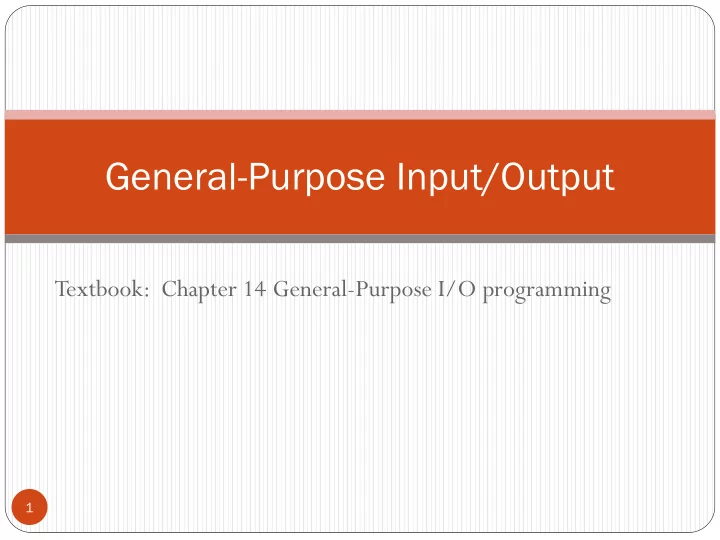

General-Purpose Input/Output Textbook: Chapter 14 General-Purpose I/O programming 1
I/O devices May include digital and/or non-digital components. Typical digital interface to CPU is via addressable registers: control reg mechanism data CPU reg status reg
Program-controlled I/O Polling The CPU checks the status of an I/O device by executing a program (“polling loop”) before initiating I/O operations. Example “READY” signal (active high) of a device is accessible through an “input port” Read & Test READY bit No Ready? Yes I/O operation
Program-controlled (busy-wait) I/O Check status Access data Yes (wait) Check status Busy? Yes No (wait) (data ready) Busy? Access data No (device ready)
Other I/O options Periodically check device, **Wait long enough to without “blocking” the program. ensure data is ready Check status Time delay** No (data ready) Access data Busy? Access data Yes Other processing (data not ready) Other processing
Output (a) and input (b) polling. PB[7:0] GPIOC GPIOB PC[7:0] PB8 PC8 GPIOB GPIOC
Busy/wait (polling) output subroutine ;Simplest method for synchronizing CPU and device ;r0 contains a character to output to a device #define OUT_STATUS 0x1000 ;8-bit status reg. #define OUT_CHAR 0x1004 ;8-bit data reg. OutChar ldr r1,=OUT_STATUS ;point to status reg. w ldrb r2,[r1] ;read status register tst r2,#0x01 ;check ready bit (bit 0) beq w ;repeat until ready=1 ldr r1,=OUT_CHAR ;point to data reg. strb r0,[r1] ;send char to data reg. bx lr ;return
Busy/wait output C example /* transmit a character string */ /* OUT_CHAR and OUT_STATUS are device addresses current_char = mystring; //char string ptr while (*current_char != ‘\0’) //more to send? { OUT_CHAR = *current_char; //write a character while (OUT_STATUS != 0); //wait while busy current_char++; //point to next char }
Busy/wait input subroutine ;return character from a device in r0 #define IN_STATUS 0x1000 ;8-bit status reg. #define IN_CHAR 0x1004 ;8-bit data reg. CharIn ldr r1,=IN_STATUS ;point to status reg. ;read status register w ldrb r2,[r1] tst r2,#0x01 ;check received bit beq w ;repeat until received=1 ldr r1,=in_CHAR ;point to data reg. ldrb r0,[r1] ;read char from data reg. bx lr ;return
Copy data from input device to output device while (TRUE) { /* read */ while (IN_STATUS == 0); //repeat until ready achar = IN_DATA; //read data /* write */ while (OUT_STATUS != 0); //repeat until ready OUT_DATA = achar; //write data } NOTE: Above assumes all 8 bits of IN_STATUS = 0 when ready. Normally we need to test a single bit (IN_STATUS contains multiple bits): while ((IN_STATUS & 0x01) == 0)
Hardware handshaking I/0 PB[7:0] GPIOC GPIOB PC[7:0] PB8 GPIOC PB9 PC8 GPIOB PC9
Example: Handshaking I/O Software ; Initialization: write to MODER to configure ; OUTPUT Device: PB7-PB0 outputs, PB8 input, PB9 output ; INPUT Device: PC7-PC0 inputs, PC8 input, PC9 output ; Handshaking output data to PB[7-0] – assume data in r2 ; Wait until Ready_For_New_Data is 1 ldr r0,=GPIOB ;point to register block SPIN1: ldrh r1,[r0,#IDR] ;read GPIOB_IDR tst r1,#0x0100 ;test PB8 (Ready) beq SPIN1 ;repeat until ready ; Output the data strb r2,[r0,#ODR] ;write to PB[7:0] ; Strobe handshaking bit New_Data_Ready to signal new data mov r1,#0x0200 ;select bit PB9 strh r1,[r0,#BSRRL] ;New_Data_Ready=1 strh r1,[r0,#BSRRH] ;New_Data_Ready=0 (Continued next slide)
Example: handshaking I/O software ; Handshaking input data from PC[7-0], return data in r2 ; Wait until New_Data_Ready is 1 ldr r0,=GPIOC ;point to register block SPIN1: ldrh r1,[r0,#IDR] ;read GPIOB_IDR tst r1,#0x0100 ;test PC8 (Ready) beq SPIN1 ;repeat until ready ; Input data ldrb r2,[r0,#ODR] ;read PC[7:0] ; Strobe handshaking bit New_Data_Ready to signal data received mov r1,#0x0200 ;select bit PC9 strh r1,[r0,#BSRRL] ;New_Data_Ready=1 strh r1,[r0,#BSRRH] ;New_Data_Ready=0
Example: UART Universal asynchronous receiver transmitter (UART) : provides serial communication. Transmit/receive one byte at a time Usually full duplex (transmit/receive concurrently) Multiple UARTs are integrated into most microcontrollers Allows many communication parameters to be programmed. External drivers/receivers often used to provide desired voltage/current levels Example: RS-232 Logic 1 voltage [-3v…-12v] Logic 0 voltage [+3v…+12v] Typically for communication up to about 50 feet
Asynchronous serial communication Characters are transmitted separately, framed by start and stop bits, with optional parity bit for error detection: optional idle n data bits parity bit condition ... bit n-1 stop start bit 0 bit 1 P time
UART CPU interface UART xmit data CPU receive status Baud control Rate gen
Serial communication parameters selected via UART control registers Number of bits per character (8 or 9 bits**). Parity generation/checking. Enable/disable (** P = 8 th /9 th “data bit” if enabled) Type of parity: Even or Odd. Length of stop bit: 1 or 2 bit periods (1/2 periods also possible) Baud rate generator Baud rate = #bits per second received/transmitted. Received data is oversampled at 16x or 8x the baud rate. Enable/disable the transmitter and/or receiver. Enable/disable interrupts triggered by various conditions. Receiver not empty, transmitter empty, error detected, etc.
Status register indicates various UART conditions/state RXNE: Receive register not empty Newly-received data available Resets when the data is read from the data register TXE: Transmitter register empty Ready to accept new data Resets when data is written to the data register TC: Transmission complete All data has been transmitted Resets if data transmission pending or in progress FE, OE, PE, NE – errors detected in received data Framing error: incorrect STOP bit (data did not fit within the “frame”) Overrun error: data register overwritten by new data before current data read Parity error: received parity did not match programmed parity Noise error: logic 1 detected in the START bit
UART software To transmit data: Verify that the transmitter can accept new data TXE = 1 (transmitter buffer empty) Write data to the data register To receive data: Detect that a new byte has been received RXNE = 1 (receiver not empty) Read data from the data register TXE/RXNE detection: Software polls the status bits Interrupt triggered by the status bits Direct Memory Access (DMA) triggered by the status bits, to move data directly between data register and memory 19
Recommend
More recommend